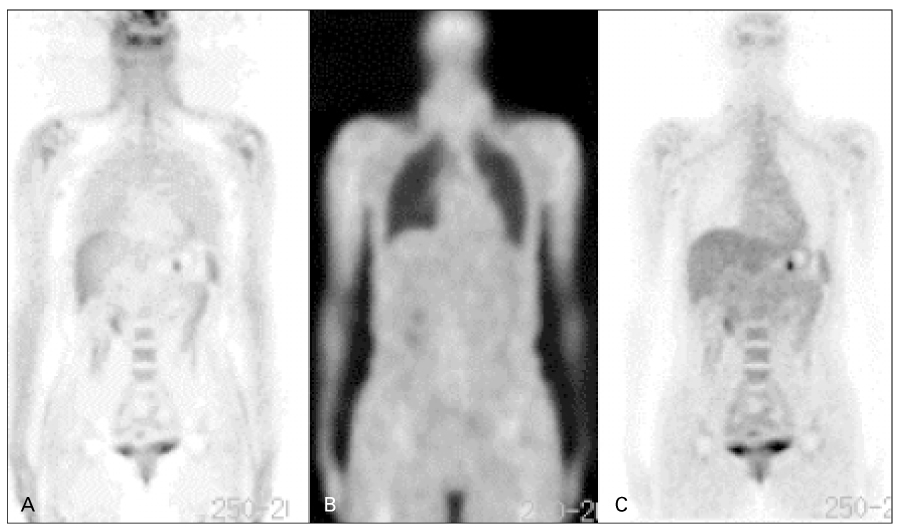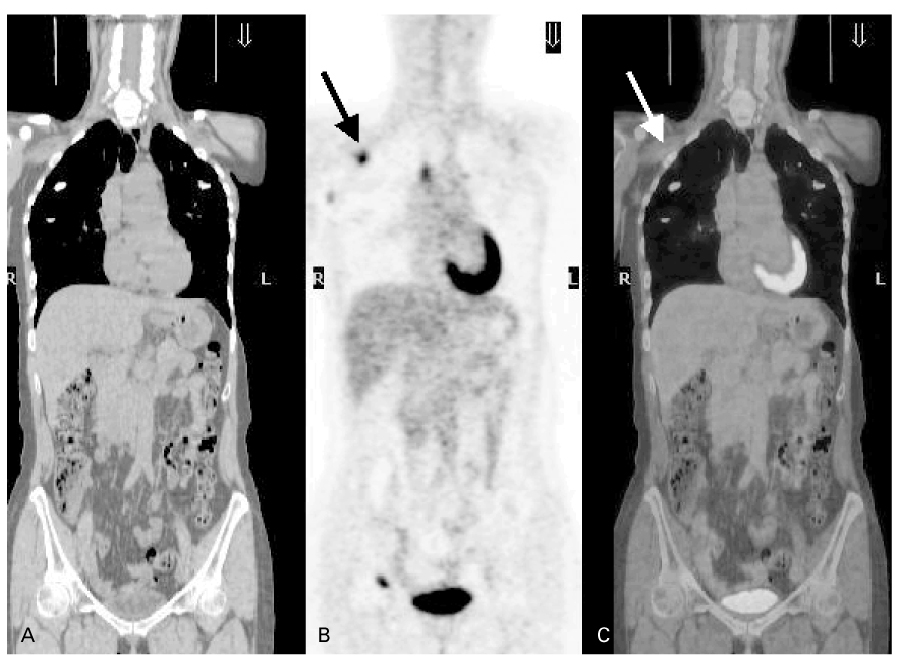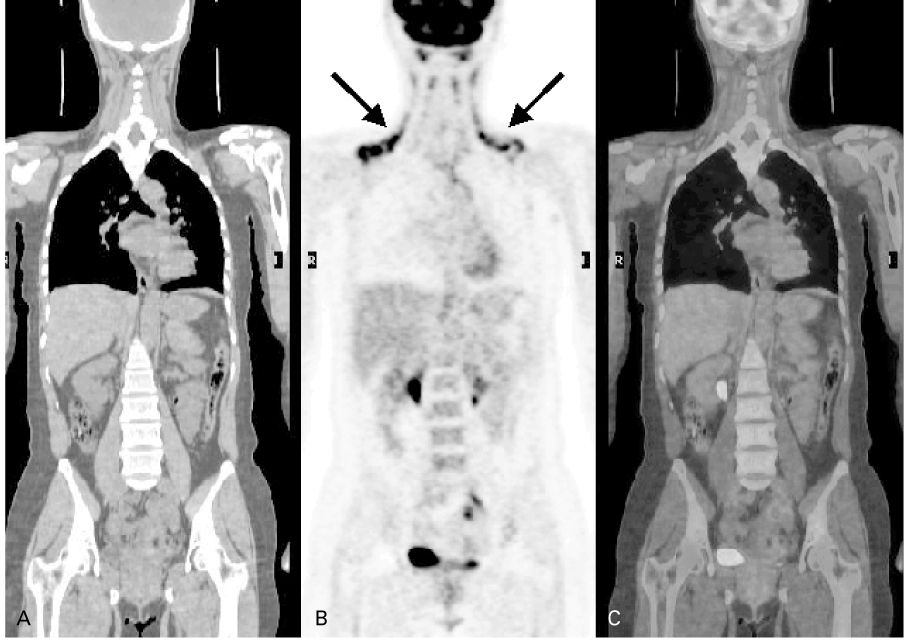J Korean Med Assoc.
2004 Sep;47(9):863-871. 10.5124/jkma.2004.47.9.863.
The Proper Use of PET/CT in Tumoring Imaging
- Affiliations
-
- 1Department of Radiology / Division of Nuclear Medicine, Yonsei University College of Medicine, Severance Hospital, Korea.
- KMID: 2183503
- DOI: http://doi.org/10.5124/jkma.2004.47.9.863
Abstract
- PET using FDG has been proposed as a functional whole body imaging modality that images various types of malignancies with relatively high sensitivity and specificity in a reasonably short time. It depicts a lesion based on abnormal glucose metabolism whereas CT as a high-resolution anatomical imaging detects malignant process mostly based on altered anatomy. PET / CT combines the advantages of PET and CT, and has a great value in early detection of disease, accurate staging or restaging, early assessment of treatment response, decision on therapeutic plans, and rapid localization of recurrence. Exact anatomical localization of a lesion with increased FDG uptake by CT is considered to be the most important factor that improves the diagnostic accuracy of PET / CT. So far, limited studies have been reported using PET / CT in comparison with PET only and mainly proved additional value of PET / CT in malignant tumors in which conventional PET already had advantages over anatomical imaging. PET / CT appears to have a promising role in the field of radiotherapy planning. Another potential of PET / CT would be in the evaluation of tumors with low FDG uptake by way of CT or new PET tracers. PET / CT is in the stage of its early infancy and further studies remain to be performed to establish applications of PET / CT in clinical oncology. In this review, we will discuss the principle of PET, the background of the emergency of PET / CT, advantages, pitfalls, and debates of PET / CT along with clinical applications and future perspectives of thereof.
MeSH Terms
Figure
Reference
-
1. Kinahan PE, Townsend DW, Beyer T, Sashin D. Attenuation correction for a combined 3D PET/CT scanner. Med Phys. 1998. 25:2046–2053.
Article2. Warburg O, Wind F, Negleis E. On the metabolism of tumors in the body. The metabolism of tumours. 1930. 254–270.3. Mac Manus M, Hicks R, Ball D, Kalff V, Matthews J, McKenzie A, et al. F-18 fluorodeoxyglucose positron emission tomography staging in radical radiotherapy candidates with nonsmall cell lung carcinoma : powerful correlation with survival and high impact on treatment. Cancer. 2001. 92:886–895.
Article4. Schoder H, Erdi YE, Larson SM, Yeung HW. PET/CT : a new imaging technology in nuclear medicine. Eur J Nucl Med Mol Imaging. 2003. 30:1419–1437.5. Cohade C, Osman M, Pannu HK, Wahl RL. Uptake in supraclavicular area fat ("USA-Fat") : description on 18F-FDG PET/CT. J Nucl Med. 2003. 44:170–176.6. Lardinois D, Weder W, Hany TF, Kamel EM, Korom S, Steinert HC, et al. Staging of non-small-cell lung cancer with integrated positron-emission tomography and computed tomography. N Engl J Med. 2003. 348:2500–2507.
Article7. Czernin J. Summary of Selected PET/CT Abstracts from the 2003 Society of Nuclear Medicine Annual Meeting. J Nucl Med. 2004. 45:S102–S103.8. Ciernik IF, Dizendorf E, Baumert BG, Reiner B, Burger C, Von Schulthess GK, et al. Radiation treatment planning with an integrated positron emission and computer tomography (PET/CT) : a feasibility study. Int J Radiat Oncol Biol Phys. 2003. 57:853–863.
Article9. Esthappan J, Mutic S, Malyapa RS, Grigsby PW, Zoberi I, Low DA, et al. Treatment planning guidelines regarding the use of CT/PET-guided IMRT for cervical carcinoma with positive paraaortic lymph nodes. Int J Radiat Oncol Biol Phys. 2004. 58:1289–1297.
Article10. Schoder H, Larson SM, Yeung HW. PET/CT in oncology : integration into clinical management of lymphoma, melanoma, and gastrointestinal malignancies. J Nucl Med. 2004. 45:Suppl 1. S72–S81.11. Cook GJ, Wegner EA, Fogelman I. Pitfalls and artifacts in FDG PET and PET/CT oncologic imaging. Semin Nucl Med. 2004. 34:122–133.12. Antoch G, Freudenberg LS, Beyer T, Bockisch A, Debatin JF. To enhance or not to enhance? 18F-FDG and CT contrast agents in dual-modality 18F-FDG PET/CT. J Nucl Med. 2004. 45:Suppl 1. S56–S65.13. Schoder H, Yeung HW, Gonen M, Kraus D, Larson SM. Head and Neck Cancer : Clinical Usefulness and Accuracy of PET/CT Image Fusion. Radiology. 2004. 231:65–72.
Article14. Wahl RL. Why nearly all PET of abdominal and pelvic cancers will be performed as PET/CT. J Nucl Med. 2004. 45:Suppl 1. S82–S95.15. Ho C, Yu S, Yeung D. 11C-acetate PET imaging in hepatocellular carcinoma and other liver masses. J Nucl Med. 2003. 44:213–221.16. Shiomi S, Nishiguchi S, Ishizu H, Iwata Y, Sasaki N, Ochi H, et al. Usefulness of positron emission tomography with fluorine-18-fluorodeoxyglucose for predicting outcome in patients with hepatocellular carcinoma. Am J Gastroenterol. 2001. 96:1877–1880.
Article17. Torizuka T, Tamaki N, Inokuma T, Magata Y, Yonekura Y, Konishi J, et al. Value of fluorine-18-FDG-PET to monitor hepatocellular carcinoma after interventional therapy. J Nucl Med. 1994. 35:1965–1969.18. Kinkel K, Lu Y, Both M, Warren RS, Thoeni RF. Detection of hepatic metastases from cancers of the gastrointestinal tract by using noninvasive imaging methods(US, CT, MR imaging, PET) : a meta-analysis. Radiology. 2002. 224:748–756.
Article19. Donckier V, Van Laethem JL, Goldman S, Van Gansbeke D, Feron P, Gelin M, et al. [F-18] fluorodeoxyglucose positron emission tomography as a tool for early recognition of incomplete tumor destruction after radiofrequency ablation for liver metastases. J Surg Oncol. 2003. 84:215–223.
Article20. Kato T, Tsukamoto E, Kuge Y, Katoh C, Nambu T, Tamaki N, et al. Clinical role of (18)F-FDG PET for initial staging of patients with extrahepatic bile duct cancer. Eur J Nucl Med Mol Imaging. 2002. 29:1047–1054.
Article21. Kluge R, Schmidt F, Caca K, Barthel H, Hesse S, Berr F, et al. Positron emission tomography with [(18)F]fluoro-2-deoxy-D-glucose for diagnosis and staging of bile duct cancer. Hepatology. 2001. 33:1029–1035.
Article22. Fritscher-Ravens A, Bohuslavizki KH, Broering DC, Jenicke L, Schafer H, Clausen M, et al. FDG PET in the diagnosis of hilar cholangiocarcinoma. Nucl Med Commun. 2001. 22:1277–1285.
Article23. Kim YJ, Yun M, Lee WJ, Kim KS, Lee JD. Usefulness of 18F-FDG PET in intrahepatic cholangiocarcinoma. Eur J Nucl Med Mol Imaging. 2003. 30:1467–1472.
- Full Text Links
- Actions
-
Cited
- CITED
-
- Close
- Share
- Similar articles
-
- Motion Correction in PET/CT Images
- Quality Assurance and Performance Evaluation of PET/CT
- Radiogenomics Based on PET Imaging
- F‑18 FDG PET/CT in NK/T‑Cell Lymphoma that Progressed from Epstein‑Barr Virus‑Associated Hemophagocytic Lymphohistiocytosis
- Unsuspected Isolated Peritoneal Metastasis of Prostate Cancer Detected with Digital F-18 PSMA PET/CT Scan




